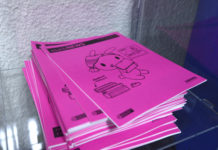The UW Robotics Team’s Mars Rover Team has a problem — a slightly comical but also somewhat serious problem. If they can’t produce a functioning drivetrain (a rover that is capable of driving and being controlled from a distance) within the next couple of weeks, they’re going to have their space in the E7 design bay revoked and given to another design team. This ultimatum had originally been issued by the design team’s coordinator back in April, following a lengthy discussion on the team’s status at the start of the fall 2023 term. Namely, they had discussed why they weren’t active in competitions and why they weren’t recruiting more members. The space isn’t free, of course, and the coordinator was of the opinion that the Mars Rover Team’s spot in the bay could be better used by a more active and successful team.
But you can’t blame the team for their struggles. It’s difficult to recruit members and keep them consistently engaged for their entire academic career when you consider UW’s idiosyncrasies and the post-pandemic environment.
“There’s this curse that’s associated with UW robotics… The way that the co-op terms works, it’s hard to have team members working on a specific project and then they have to stop for four months and come back to that,” says Saheed Quadri, a first-year mechatronics student and the mechanical lead for the team.
Maya Wei, a third-year environmental engineering student and the business lead for the team, further describes this “curse” by detailing the team’s personal difficulty with senior team members passing on their knowledge to new team members. “After COVID, we took a pretty big hit because we went all online, all asynchronous, so it was hard to keep track and teach everyone how to do stuff in person when no one’s in person.” Wei has been on the team for four years, the longest out of all the department leads, but she has yet to attend a competition — doing so had proven a bit difficult considering the team was left with no guidance or knowledge from the more experienced upper years that have since graduated. “Every single team member that had gone to competition prior to COVID was no longer on the team by the time… [it] started back up. The knowledge transfer wasn’t really there,” says Josh Magder, a second-year mechatronics student and the firmware lead.
Regardless of the circumstances and the stress that this ultimatum brings, the leads and members are all hopeful that they can meet the deadline, citing that they were already about 80 per cent done. They emphasized that even if they did fail and lose the space, the drive to keep the rover going would still exist — lockers in E7 would be used to store equipment instead and the members would find a different space to collaborate. The leads saw their failure as more an inconvenience rather than a death sentence.
This motivation to succeed and survive comes from something bigger than just wanting to keep their space — it’s sentimentality. “I’ve been with the team for a long time,” says Wei, “[and I] kind of am so attached to the team already and just the experience with the team for my university career, it’s deeper than just a club.”
“I wouldn’t have gotten my first co-op if it wasn’t for [UW Mars Rover]… And if I have the opportunity…whenever there’s a new member, I try to give them as much knowledge as I can because that’s the way I was treated when I joined here and I really want to continue that sort of environment” says Rayyan Mahmood, a first-year electrical and computer engineering student and the electrical lead. “And I think the Mars Rover is objectively the coolest project there is.”
And this project is definitely one that takes time, with team members generally spending about 5-10 hours a week on their duties. Who would have guessed that making a rover is complicated? “[You have to start] from a system level of things to know what you want to have in your rover. And then on the mechanical side… you’d have diagrams first on CAD, in order for team members to draw off,” says Quadri. “This skeleton diagram kind of tells you roughly where components need to be…what their dimensions need to be.” In terms of project management in the mechanical team, Kenesto, a cloud-based product that allows them to have one source CAD file to be shared between all team members, and Protocase, a company that manufactures sheet metal parts in a finer tolerance than can be made in Waterloo’s machine shop, are both sponsors that help to streamline the team’s work.
The electrical team’s main job is power management. “We have all these different components that require large amounts of power… We have our main power distribution board, a PCB, that delivers [this] power. So, for like our motors… [and] the brain of our rover, the NVIDIA Jetson [and] the PCB is responsible for all of that.” The team also creates special PCBs, and their most recent one is a localization board that contains a GPS receiver and accelerometer to pinpoint the rover’s position.
Once everything is constructed, it is the firmware team’s job to integrate everything together. “[Testing] the full drivetrain system, trying to establish communication between all the different components… [We’re] instrumental in [bridging the gap between] the mechanical work and the software work and the electrical work to get the rover to actually drive,” Magder says.
And the person in charge of getting the money and people necessary to make all this possible is Wei. “I find ways to get people to come together, try to unify them…get them inspired. And you know, reaching out to people who might want to sponsor [us] because you know, that thing ain’t for free,” Wei says.
Come the end of June and the completion of the drivetrain, it’s full speed ahead for the team as they set their sights higher to add more functionality to the rover, get more faculty advisors, revive the team, prioritize teaching and knowledge transfer to new members, and finally attend a competition. We at Imprint wish them the best of luck in their future endeavours and hope they continue aiming for the moon. Even if they miss, we’re sure they’ll still end up on Mars.































